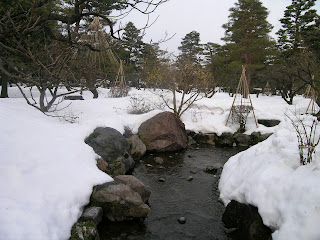It is an open secret that modern GI endoscopy, especially diagnostics and treatment of an early GI cancer, originate from Japan. A "Japanese style" endoscopy implies precise diagnostics of minor and minute mucosal changes.
Professor Tohru Itoh, Head of the Endoscopy Department at Kanazawa Medical University Hospital, was the tutor of the training course.
I was provided with the personal desk, the Internet access and a library pass. Every day, except Sunday, I was at my desk from 8.30 a.m. to 10.00 p.m. Of course I had lunch-time, but sometimes I didn't have time for lunch breaks, especially on Tuesday and Thursday (these are the busiest days). My duty was to took part in all endoscopic examinations (about 300) and operations (about 10) as well as read scientific literature and do sketches.
Within the framework of the endoscopy training course at Kanazawa Medical University two Hands-on trainings on ex-vivo pig stomachs on the base of the Endoscopy Department were held on January 21, 2011 and on February 24, 2011. They were devoted to advanced therapeutic technologies in GI endoscopy. The highlight of the hands-on training was Endoscopic Submucosal Dissection (ESD) technique. A dedicated gastroscope (Olympus® EVIS LUCERA video gastroscope GIF-Q260J), electric ESD knives (IT-knife and Hook-knife Olympus®), and an Erbe electric generator were employed.
A total of 5 ESDs of “target lesions” on a healthy mucosa were performed by following the technique described. All target lesions were located in the upper body great curvature of the stomach. Resection specimens ranged from 2 cm to 5 cm in length (median: 3,5 cm). ESD duration ranged from 40 to 60 minutes (median: 50 minutes). ESD could be completed in all cases (technical success: 5/5 = 100%).
 |
| Hands-on Training February 24, 2011 |
 |
| Resected Specimen |
 |
| One more specimens |
During the training course I mastered: the principles of early GI cancer screening and detection, indications for endoscopic treatment of early GI cancer, all steps of ESD performance and methods for preventing complications.
The staff of the University Centre of International Exchange as well as the staff of the Endoscopy Department was very friendly and helpful. I also enjoyed the fact of my perfect accommodation in a well- furnished room of the University Dormitory.
I found the "Japanese style" endoscopy exemplary because it's congenial to me in it essence and in everyday clinical practice at the Yaroslavl Regional Cancer Hospital I follow the same principles. The base ESD technique is extremely important for employing this therapeutic method for the treatment of early GI cancer. The experience gained by me is unique and extremely important for my future professional work.
I owe the success of my training course to professionalism and superb teaching skills of Professor Tohru Itoh.
 |
| Professor Thoru Itoh and Mrs. Nozaki-san, Doctor's Office Room |
 |
| Professor Tohru Itoh, Dr. Kawaura, Mrs. Nozaki-san | |
 |
| Festive Dinner: Dr. Kawaura, Dr. Kitakata, Dr. Urashima, Dr. Hamada, Dr. Minato, Mrs. Nozaki-san |
 |
| Festive Dinner: Professor Tohru Itoh and Dr. Gvozdev Alexey |














































